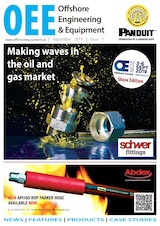As the name suggests, the umbilical system is the lifeline for the subsea structures used in offshore oil and gas production. It provides the link from the host facility through which control is exercised, power is transmitted and utilities such as injection chemicals are supplied to the subsea wells. With the continuing trends in subsea to shore installations and operations in deeper and deeper locations, umbilical systems have to cope with increased stresses.
The umbilical is a long, flexible construction - its length can be anything from a few miles to more than 180 miles - which consists of tubes, cables, armouring, fillers and wrapping contained within a protective sheath. The multiple functions it performs and the demanding environment in which it is installed and operates, mean that the umbilical is necessarily a very hi-tech product which must perform reliably while in operation.
Due to the critical nature of the systems and valves which are controlled by the hydraulic umbilicals throughout the subsea networks, it is essential that the hydraulic fluid be cleaned to the required specifications. The lines and connections must also be regularly checked for leakage to ensure that they operate correctly and with the necessary reliability and efficiency. In order to carry out the cleansing and checking procedures a test rig is required which is capable of flushing out the entire umbilical length and submitting it to a pressure test.
Due to the size of the pump needed for the operation these tests must traditionally be carried out on-shore which necessitates complex logistics and becomes extremely inefficient. To improve the efficiency of our clientís process, a leading manufacturer of bespoke umbilical products, wanted to develop a test rig which would be suitable for off-shore use. The list of design criteria was long and exhaustive. The new test rig had to be enclosed in a custom steel framework which would allow it to be lifted by a crane and also be able to fit inside a standard cargo container as well as act as protection from occasional knocks.
With the dimensions of the rig established, the heart of the system would be the high pressure pump, which would have to be capable of producing pressures up to 15,000 psi (1035 bar) with flows between 3 - 15 US gallons/min (11 - 56 litres/min). Achieving these figures would reduce the overall time required to fill, flush and pressure test the umbilical system, which in turn would reduce the cost of the installation and sale of umbilicals. With the test rig being designed for off-shore use it was essential that the pump offered the highest degrees of reliability.
In addition to these standard requirements, and to make it suitable for use on the pumping platform, the entire rig needed to be intrinsically safe; meeting Class I, Div II classification for both offshore and onshore use. The test rig also required the ability to filter the fluids being used in the test procedure to ensure the umbilical pipes were not contaminated. The filtration package would require 3 micron filters to be installed on both the suction and the pressure sides of the main oil reservoir to prevent any contamination during the testing procedures. Additionally, two return filters were added to ensure minimal contaminants returned to the reservoir.
The challenge of supplying a pump capable of meeting these demands while also offering complete reliability was offered to RMI Pressure Systems. RMI designed the steel frame of the test rig around its Trimax S250 high pressure pump. The pump is controlled by a Toshiba variable frequency drive (VFD) and Omron PLC and is suitable for both the flushing operation and the high pressure testing. Using a single pump for both procedures reduces the overall operation time which in turn reduces costs.
Mike Sherman, marketing manager for RMI commented: "In the past the client had contracted out the task of testing and flushing its umbilical systems, but there was a requirement to bring these operations back 'in-house', which would allow greater control over procedures and documentation. The completed test rig provided this facility with a much more efficient pump, providing substantial savings in time, six days down to two days, and money to complete the testing and flushing operations."
The Trimax range of crankshaft-driven, reciprocating pumps provides high efficiency pumping at pressures up to 1050 bar and flows up to 610 litres/min. The S200 and S250 are both three piston, crankshaft driven, positive displacement pumps. The design of the pumping system enables the units to operate in hazardous conditions without modification, however to meet the intrinsically safe specification for the entire test rig, several modifications were required, including the installation of a nitrogen purge system for the VFD and various explosion-proof fittings.
All of the pumps are fitted with a robust, fully supported crankshaft with con-rods assembled with lead bronze big and small end bearings. Extremely high wear-resistant solid ceramic plungers, combined with Kevlar fibre seals provide long-lasting, high-pressure sealing. All pumps undergo a rigorous testing programme prior to dispatch, which includes oil temperature and pressure checks plus vibration monitoring, as well as the normal pump performance criteria.




